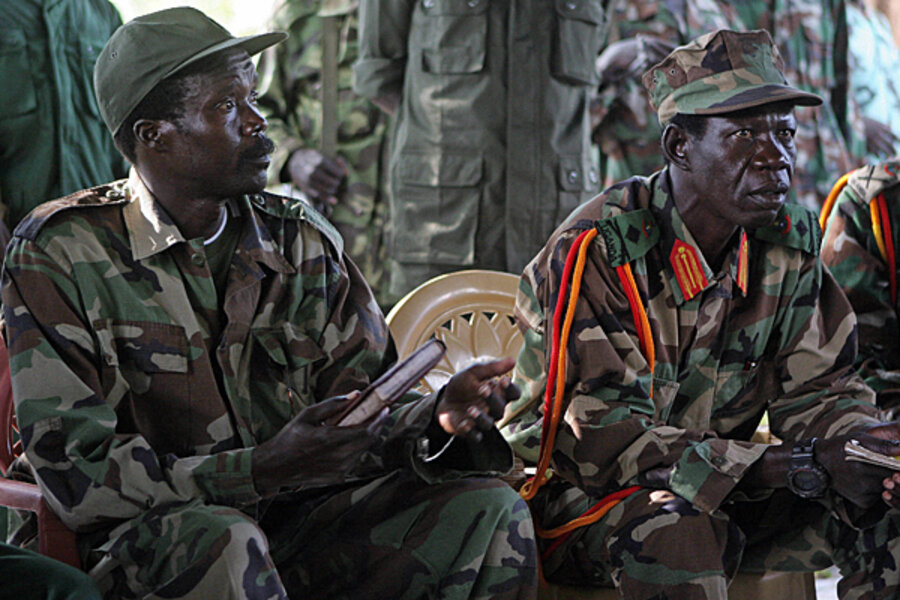When Joseph Kony almost came in from the cold: Juba peace talks
Loading...
When Joseph Kony finally showed his face to the world, in an exclusive television interview with British journalist Sam Farmar in the jungles of the Democratic Republic of Congo, he was wearing a blue sports t-shirt and camouflage pants.
The timing was propitious. The International Criminal Court had just lodged its first-ever war-crimes charges against Mr. Kony and demanded his arrest. The Ugandan government was expressing willingness to negotiate a peaceful settlement to what at the time was a 20-year insurgency. The South Sudanese government had offered to hold the peace talks in Juba. And here was the man of the hour, a man who denied charges of abducting child soldiers, of mutilating or murdering his enemies, a man who promised his willingness to seek a peaceful settlement.
“I’m a person like you,” Kony told the British reporter. “I have eyes. I have a brain. I wear clothes also. I’m a freedom fighter, who is fighting for freedom in Uganda, but I’m not a terrorist.”
This was the beginning of a two-year effort of Kony to rebrand himself and his Lord’s Resistance Army (LRA) in the eyes of the world. Accused of kidnapping at least 30,000 children as porters, soldiers, and sex slaves since he launched his insurgency on behalf of northern Uganda’s Acholi people against the mainly southern Ugandan Army of President Yoweri Museveni in 1988; accused of forcing children to murder their own parents in order to break ties to their home communities; accused of mass murder of perhaps 100,000 people and feeding his army through pillage; Kony had already been labeled a mass murderer by human rights groups and as a terrorist by the US government. But in the summer of 2006, he presented himself as a man of peace.
“That one is not true,” Kony said of the allegations that his troops mutilated children. “That is the propaganda which Museveni made. That thing was happening in Uganda. Museveni, he went into the village, and he cuts the ear of people, and he tells the people that thing was done by the LRA.”
But just a few months later, Kony’s own deputies met up with Mr. Museveni’s delegates for peace talks in Juba. Museveni announced that his government would grant Kony and his top commanders amnesty and shield them from arrest warrants of the International Criminal Court.
But Kony never came out of the bush. Instead he sent two deputies, Vincent Otti and Martin Ojul, along with a group of camouflage-clad functionaries.
In Juba, South Sudan's Salva Kiir – who was also Sudan’s vice president under the 2005 Comprehensive Peace Agreement with Khartoum – told reporters in June, "When we start to talk with Kony and the Government of Uganda, in a very short time, we will bring peace to northern Uganda and by that we would also bring peace to southern Sudan."
The talks started off well. In late August 2006, the LRA and Ugandan government agreed to a cease-fire, and LRA commanders agreed to withdraw from Uganda into southern Sudan and to remain in displacement camps protected by the South Sudanese government. But by late September, the LRA team walked out of peace talks, accusing Ugandan forces of attacking an LRA camp. Another truce was signed in November 2006.
It was a pattern that would repeat itself over the next 18 months: Talks, military incidents, recriminations, reconciliation, and talks again.
The final stumbling block may have been the war-crimes charges brought by the International Criminal Court. Kony’s team refused to sign any deal unless Uganda committed itself to amnesty. In February 2008, Uganda and the LRA team signed a deal that would divert any future LRA war-crimes trials to a special tribunal under Uganda’s High Court. By March 28, Kony was supposed to emerge from the bush to sign a deal.
He never did.
In the end, in April 2008, Kony declined signing the negotiated deal, claiming he could not sign a deal that he had not read. Martin Ojul was fired as negotiator, and so was his successor, David Nyekorach-Matsanga, both of whom were accused of keeping Kony out of the loop. Otti was later shot in the fall of 2008, apparently by Kony himself, for reportedly having accepted hundreds of thousands of dollars from the Ugandan government to act as a spy.
In June 2008, Kony was still talking about “peace through negotiations” in a phone interview with Radio France International reporter Billie Kadameri, but by then, it was too late. Both Kony and Museveni had set in motion an almost-inevitable return to conflict. Kony’s troops had attacked their South Sudanese hosts, and began abducting soldiers again, this time from Sudan and Congo. Museveni had begun preparations for a new military operation called Lightning Thunder.
On Christmas Day 2008, Kony’s forces killed 400 near the Congolese town of Dungu, apparently in retaliation for Lightning Thunder. His forces have been on the run, into the Central African Republic, South Sudan, and the DRC, ever since.
* Keep Calm, a winking reference to the World War II slogan "Keep Calm and Carry On," is a new blog that aims to provide a bit of context to help make sense of confusing news events.







